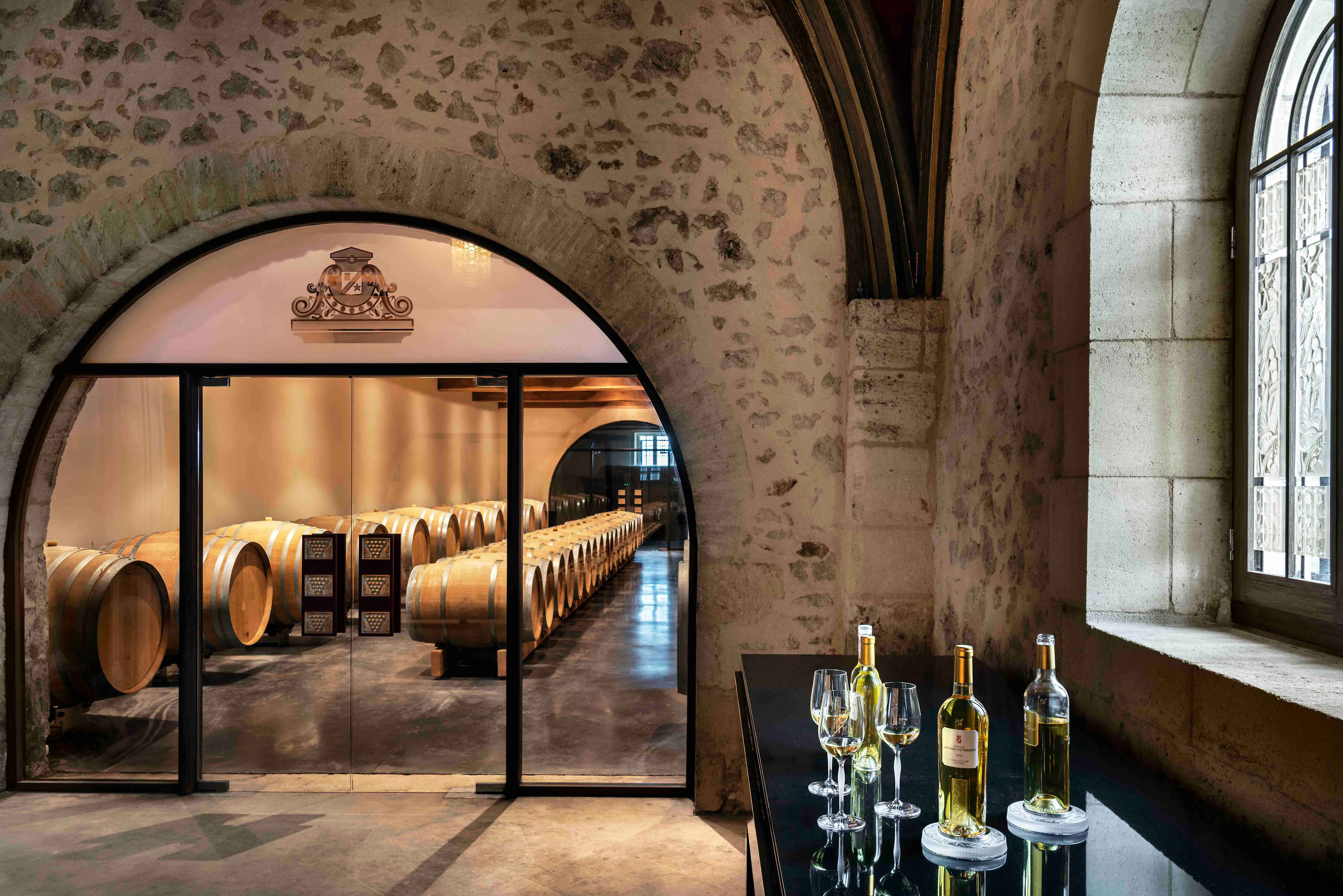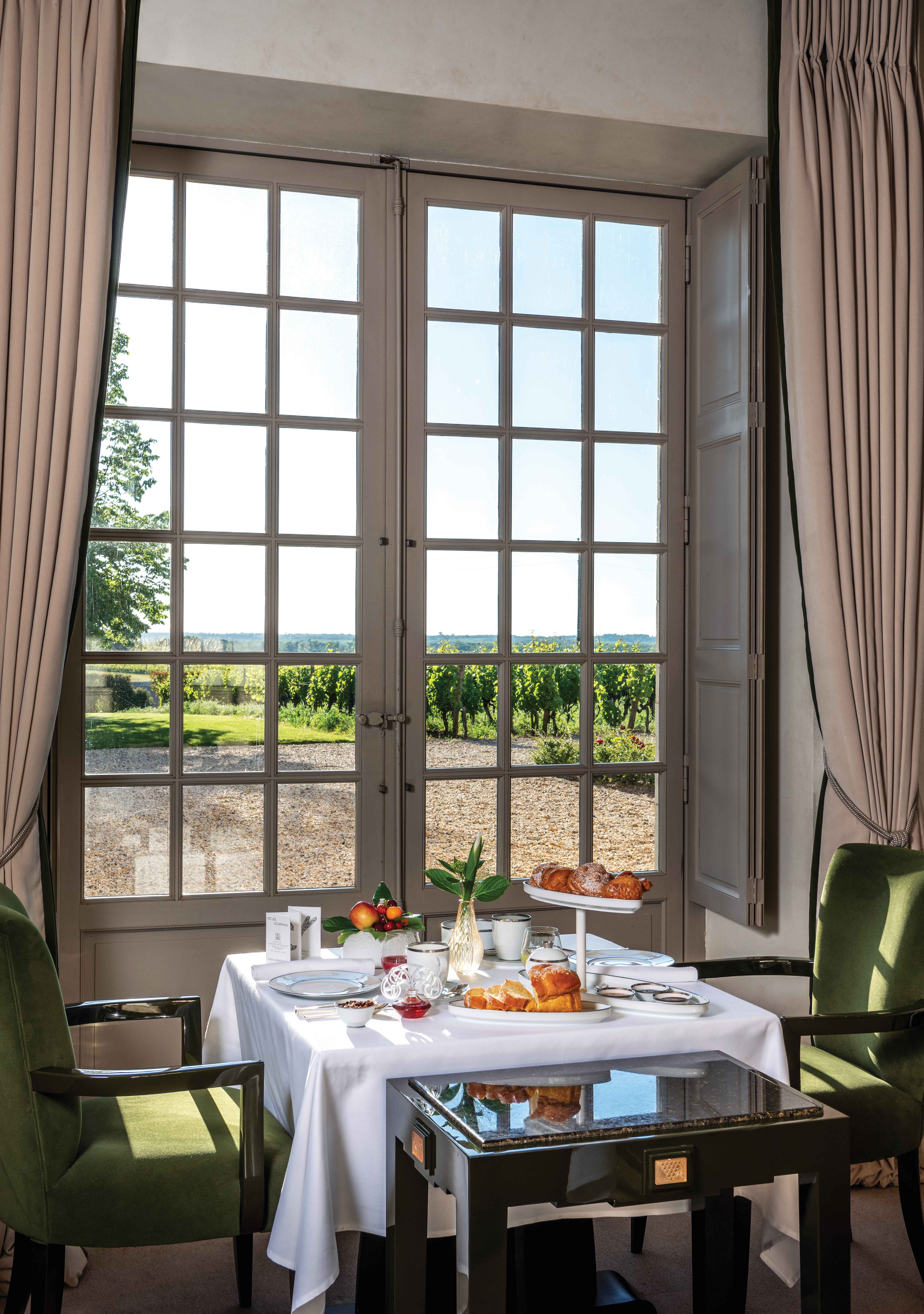It’s the colour of liquid gold and made from Semillon, Sauvignon Blanc and Muscadelle grapes. Sauternes is the most challenging, costly and labour-intensive wine in all of Bordeaux to produce.
As the grapes used for sweet white Bordeaux wine must be attacked by botrytis cinerea, better known as noble rot (the area’s micro-climate being conducive for the fungus to develop), the vines can take weeks to pick since the pickers sometimes need to pluck the berries one at a time. The yields of the Sauternes region are extremely low, making for its rarity, as the winemakers there have focused on wine quality, whilst others concentrated on volume.
Although the Sauternes appellation is the smallest of Bordeaux, it boasts 12 first growths (Premiers Grands Crus Classés) — the greatest concentration of first growths — compared to just five among the Médoc’s red wines, according to the 1855 Bordeaux Classification ranking wines based on their commercial value and quality. Château Lafaurie-Peyraguey was included in this list.
Thomas Jefferson, the third U.S. president, who visited Bordeaux in the 18th century, was a fan. King Alfonso XII of Spain, who had declared Lafaurie-Peyraguey to be his favorite wine, bought a barrel of the 1858 first growth for 6,000 gold francs.
In the 19th century, Sauternes was incredibly popular and prestigious, but since then, it has fallen out of favor. The old-fashioned belief that this high-sugar, liquor-like wine is for senior citizens to enjoy with foie gras at Christmastime is one that Sauternes now wishes to dispel.
 The bar
The bar
Mr. Silvio Denz, a Swiss businessman in the perfume and wine trades, is keen to restore and rejuvenate the image of this luxury product among today’s wine drinkers, his objective being to continue the work begun in 1618 and to honor the vision of Château Lafaurie-Peyraguey’s successive owners spanning four centuries so that this French art de vivre will shine once again. He has been actively calling for more facilities to entice tourists to the Sauternes area.
After acquiring French brand Lalique in 2008 and Château Lafaurie-Peyraguey in 2014, he opened the estate to the public for the first time last year on the occasion of its 400th anniversary, together with the new Lalique Hotel & Restaurant to attract wine tourists in search of a luxury Bordeaux experience. A peaceful, discreet retreat set on high ground in the tranquil village of Bommes amidst the vineyards of Sauternes, it is the first time an 1855 first-growth terroir has housed a luxury hotel. Within months of opening, it was accredited as a member of the Relais & Châteaux collection, granted a five-star rating and one Michelin star for its restaurant.
 The Duplex Suite
The Duplex Suite
Today, it is the sole luxury hotel in the South Gironde department, and the first and only Michelin-starred restaurant in the Sauternes region. It is also the third Lalique hotel in France, following Villa René Lalique that opened in 2015 and Château Hochberg in 2016, both located in Alsace.
Since 2014, upon Mr. Denz’s initiative, the château has produced two dry white wines for those with less sweet tastes: Le Grand Blanc Sec de Lafaurie-Peyraguey and Le Lys de Lafaurie-Peyraguey. Annual production has decreased because Mr. Denz wanted to use only the most qualitative parcels, and remains stable at 40,000 bottles.
Mr. David Bolzan, Managing Director of Vignobles Silvio Denz, says, “Silvio Denz bought Lalique and made a similar observation to the one we made at Lafaurie-Peyraguey: Both brands had been very advanced in a high-end and noble environment, but also very conservative. Very quickly, Lalique became a lifestyle brand and not only a crystal brand.
This is what we strive to create at Lafaurie-Peyraguey: a lifestyle product in a unique setting. It started with the engraved wine bottle (featuring the Woman and Grapes motif created by René Lalique in 1928). Lafaurie-Peyraguey will be the first brand to modernize this great wine to make you want to consume it.”
Design Forward
 The restaurant: a 17th-century main building and a modern extension
The restaurant: a 17th-century main building and a modern extension
Lady Tina Green and Pietro Mingarelli were commissioned to design the Lalique Hotel & Restaurant, offering three guest suites and 10 rooms, some structured with exposed wooden beams. The designers behind the Lalique Maison collection of furniture and accessories were inspired by the beauty of the location.
The property had never previously served as a hotel. “This project required a long period of reflection,” Mingarelli states.
“So as to sustain rather than transform its heritage, we had to feel the resonance of the place and adapt our vision to the buildings’ strict geometry. It was a difficult balance of tension between form and function.”
Every element speaks of a synergy between wine and crystal. Upon entry, one is struck by a large crystal panel depicting birds amidst the grapevines, while in the cosy lounge, the eye is immediately drawn to the bar filled with decanters created by Lalique in partnership with spirits companies such as The Macallan (whisky), Hardy (cognac), Beluga (vodka) and Patrón (tequila).
The first suite features a Lalique Champs-Elysées chandelier depicting the leaves of plane trees lining the world’s most beautiful avenue suspended from a high ceiling; the second in the medieval tower offers guests a reading room; and the third is a duplex with views of the ancient gatehouse and its 13th-century foundation walls.
 The Chapel, located next to the cellars
The Chapel, located next to the cellars
“René Lalique was born in the Champagne region and came from wine culture, so he was very familiar with this world,” Mr. Bolzan explains. “He was known as a creator and was passionate about three things: women, fauna and flora. During his art deco period, especially in the late 1920s, he was inspired by the area and many of his best-known designs feature grapes.”
Showcasing René Lalique’s passion for vines, grapes and wine, Lalique crystal plaques bearing grape cluster designs are set into bed frames, chests of drawers, bedside tables, bookshelves, fireplaces, mirrors and sofas. They are even embroidered onto bath towels and engraved on tap handles.
The green and deep red tones of the furniture and fabrics recall the colors of the vineyards and wines. Windows frame the surrounding countryside, making for extraordinary views. There’s also a library housing a large selection of Lalique vases and panther sculptures and books on the pairing of French savoir-faire and savoir-vivre: the history of Sauternes and Bordeaux wines, the vineyards, René Lalique and his works.
 The breakfast room
The breakfast room
“Each piece of furniture has been made bespoke and with color inspiration taken from the surrounding vineyards — earthy tones combined with red and gold — lit up with crystal and an unwavering attention to detail and a sensitivity to the original building,” notes Mr. Bolzan. “Original features such as beams, shutters and individual nooks in the rooms have been enhanced and retained to give a timeless elegance.”
A chapel lies at the heart of the estate, as Baron Nicolas Pierre de Pichard, who owned the château from 1746 to 1794, had a reproduction of the 1491 baptistery from his baptismal church in Bordeaux built there. It now features historic and contemporary Lalique pieces, paying homage to René Lalique’s ecclesiastical works, and can be used for private or religious ceremonies such as weddings and baptisms. Above a red-and-black marble altar designed by Mingarelli are stained-glass windows decorated with the image of blackbirds and grapes and the crystal Eternal Belief cross by Damien Hirst inlaid with colored pills.

The 40-seat restaurant features a contemporary, light-filled extension with floor-to-ceiling glass windows — perfect for watching the sunset over the vineyards — built by renowned Swiss architect Mario Botta, who ensured it remained true to the spirit of the historic building. The ceiling is adorned with 120 Champs-Elysées leaves in shiny gold crystal echoing the color of Sauternes wines, and on the table are Christofle napkin rings encrusted with grape-patterned crystal, Fürstenberg porcelain plates, Hirondelles crystal knife-holders in the shape of a swallow and bespoke wine bottles engraved with the Woman and Grapes design laid out as welcome plates.
Here, French chef Jérôme Schilling — former executive chef of the two-Michelin-starred Villa René Lalique restaurant — leads a brigade of 10, including pastry chef Stéphane Corolleur. The gastronomic experience is not just about pairing Sauternes wines with the dishes, but incorporating the winemaking process into the cuisine. Take for example Schilling’s foie gras marinated in squid ink and poached in Sauternes at 72 degrees Celsius, served in a delicate clay shell printed with René Lalique motifs — a technique taken from the Lalique factory in Alsace — or turbot steamed between two barrel staves that spent months being used to mature Sauternes.
Schilling remarks, “It’s all about bringing out the qualities of Sauternes in precise gastronomic pairings, enhancing its aromas, highlighting its various shades and playing with textures.” Head sommelier Adrien Cascio has conceived an ambitious wine list with 2,500 wines, the majority of which come from Mr. Denz’s personal collection.
Visitors may visit the four underground cellars, home to a remarkable ensemble of 350,000 bottles, as well as the vat house and wine boutique with daily tours and tastings. A vertical selection of Château Lafaurie-Peyraguey’s top wine from 1985 to 2015 that has never left the estate is available, as well as wines from Mr. Denz’s other vineyards.
In its first year of operation, the hotel welcomed over 3,500 guests, but Mr. Bolzan sees the potential to attract even more tourists, saying, “We are developing more and more different sensorial experiences. We have a large capacity to welcome tourists today and make them discover all the exceptional pieces. We offer a unique wine tourism experience for a clientèle fond of an exceptional environment.”







 The bar
The bar
 The Duplex Suite
The Duplex Suite
 The restaurant: a 17th-century main building and a modern extension
The restaurant: a 17th-century main building and a modern extension
 The Chapel, located next to the cellars
The Chapel, located next to the cellars
 The breakfast room
The breakfast room





 Back
Back
